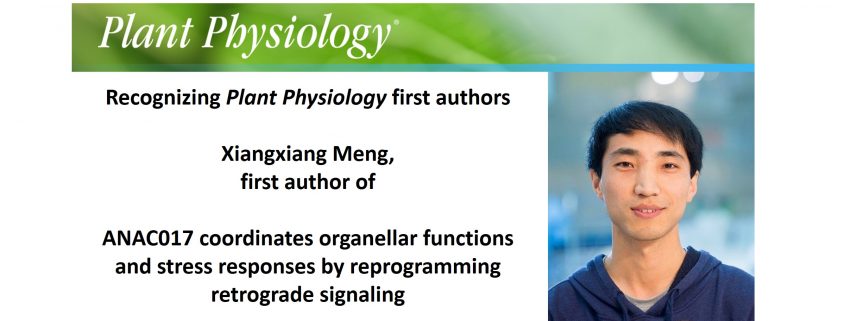Recognizing Plant Physiology first authors: Xiangxiang Meng
Xiangxiang Meng, first author of ANAC017 coordinates organellar functions and stress responses by reprogramming retrograde signaling
Current Position: PhD student, Department of Animal, Plant and Soil Science and Australian Research Centre in Plant Energy Biology, School of Life Science, La Trobe University, Melbourne, Australia
Education: MS, Department of Horticulture, Zhejiang University, Hangzhou, China
Non-scientific Interests: Reading, hiking, and table tennis
Brief bio: I am fascinated with plant stress responses and how plants cope with adverse growth conditions. My master’s thesis at Zhejiang University in Hangzhou, China focused on the genetic variation in phosphorus uptake of watermelon under low phosphorus stress. In 2015, I was fortunate to join the laboratory of Prof. Jim Whelan at La Trobe University in Melbourne, Australia to study the importance of mitochondria and retrograde signaling for stress tolerance. My work contributed to show that the transcription factor ANAC017 coordinates signaling pathways by activating mitochondrial stress responses and by down-regulating chloroplast function, which involves autophagy and senescence mechanisms. These findings show that the ER membrane-tethering of the constitutively expressed ANAC017, and its controlled release, is crucial to fine-tune a fast reactive signaling cascade. This positions ANAC017 as a high-level regulator of plant stress responses with mitochondria as their sensors.
姓名:孟祥祥
现在职位:澳大利亚La Trobe 大学 生命科学学院 动物植物土壤专业 澳大利亚植物能源生物研究中心 在读博士。
教育经历:浙江大学 园艺系 硕士
兴趣爱好:读书,徒步,乒乓球
简介:本人热衷于对植物胁迫响应及植物如何应对逆境条件的研究。我在浙江大学园艺系读硕士期间的课题是关于低磷条件下西瓜磷吸收的基因型差异研究。2015年我幸运地加入到La Trobe 大学Jim Whelan实验室研究线粒体及其反向调控对于胁迫抗性重要性的课题。我们的研究发现,ANAC017转录因子能够通过激活线粒体胁迫响应和抑制叶绿体功能来调节信号途径,并参与自噬及衰老机理的调控。这些发现表明内质网膜系的ANAC017的组成型表达及其释放对于精细调控一个快速反应的信号级联反应有关键作用。这种定位使得ANAC017成为一个以线粒体为感应器的高层级的植物胁迫响应调控因子。




